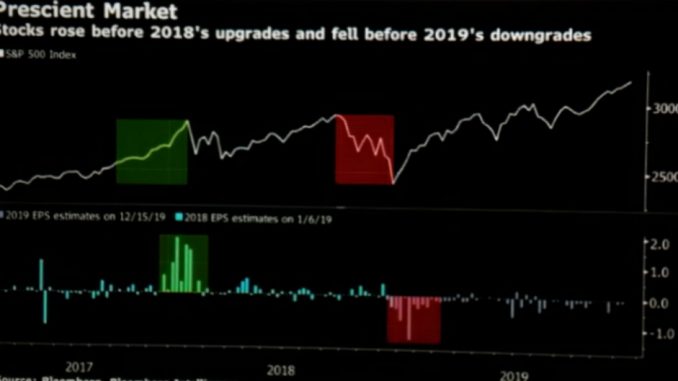
(Bloomberg) — Should American investors, $6 trillion richer after the stock market’s best year in six, take shelter now, convinced a reckoning is at hand and the good times won’t last? As far as earnings, the economy and equities themselves are concerned, the answer is no.
Or at least, not necessarily. Past performance isn’t always indicative of future results. But if you’re looking at the size of this year’s gains and deciding they somehow doom 2020 to being a disaster, history suggests a more nuanced approach is called for.
Good stretches in stocks are not usually followed by bad ones. When the S&P 500 has risen 20% or more over a calendar year, it’s had positive returns in the next one two-thirds of the time. Average gains were more than 6.5%, according to Bespoke Investment Group. Record stocks have usually foretold improving earnings, as well.
“The market is forward-looking and taking in all the positive data, and there’s more positive data right now than negative,” Katerina Simonetti, a senior vice president at UBS Financial Services, said in an interview at Bloomberg’s New York headquarters. “The market is positioned for growth in 2020.”
It’s rare, though not unheard of, for the economy to tank right after a rally as big as this. Since 1930, there have been 17 calendar years in which the S&P 500 gained 25% or more. A recession followed three times — in 1990, 1981 and 1937. Economists surveyed by Bloomberg place the odds of a recession in the next 12 months at 30%.
While recessions and big rallies are both probably too rare to generalize much about their connection, usually the market isn’t this buoyant just before a downturn.
Equities are a mirror image from last year’s fourth quarter. One explanation for that meltdown is that it represented investors sussing out a poor year for corporate earnings and adjusting prices accordingly. What about now, when the S&P 500 has jumped 9% since the start of October, gaining in 11 of the last 12 weeks? If you believe share prices are prescient, it bodes well for 2020’s tidings.
An October study by the research firm CXO Advisory Group LLC looked at the relationship between earnings and market moves and found that stocks usually anticipate corporate results, not the other way around. The “strongest indication” observed in the study was that equity returns lead earnings by a quarter.
The connection may have been at work last year, when the worst fourth quarter of the bull market preceded a raft of earnings downgrades. Expectations for 10% profit growth were dashed, and projections tracked by Bloomberg Intelligence fell by the most since 2016, when S&P 500 firms were in the midst of an earnings recession.
A similar prescience was on display in 2017, too. The S&P 500 jumped 6% in the fourth quarter, topping off a 20% gain, in anticipation of President Donald Trump’s corporate tax overhaul. In the three months that followed, forecast profit growth for 2018 surged nearly seven percentage points, and by the end of 2018, S&P 500 companies had seen three separate quarters in which earnings rose more than 20%.
Strategists at Ned Davis Research also studied the stock-profit connection and came up with similar — if not identical — conclusions. Their data found equity prices often move inversely to earnings in real time. That is, strong earnings growth is often met with indifferent stock performance, a sign investors are more interested in quarters to come. In years when profits have jumped more than 20%, the S&P 500 has risen 2.4% on average, the firm found. Meanwhile, when growth has been below 5%, the benchmark has gained 12.2%.
This year and last year have fit the model. Double-digit profit growth in 2018 was met with some of the worst stock returns this decade, and stagnant earnings this year have garnered some of the best.
According to Bank of America Corp., any upside for U.S. stocks next year will need to be driven by rising profits. To get to the firm’s year-end S&P 500 target of 3,300, earnings will have to do the heavy lifting, since years of extreme multiple expansion are typically followed by years of “flattish to contracting multiples,” said strategists including Savita Subramanian.
Expectations may be baked into stock prices already, but some investors worry the market may not be as efficient as it was years ago. David Spika, the president of GuideStone Capital Management, says the proliferation of passive, systematic, and quantitative strategies has diluted the market’s foresight. Alex Pire, head of client portfolio management for Seeyond, a subsidiary of Natixis Investment Managers, has a similar concern.
“That’s what the stock market is supposed to be — it’s a discounting mechanism,” Pire said in an interview at Bloomberg’s New York headquarters. But “it is taking longer than it used to. Potentially what that means is we could get into a situation where the market continues to rise, yet we’re seeing the rest of the economy actually doing very poorly, and then you have a much broader cliff that happens.”
*story by Bloomberg